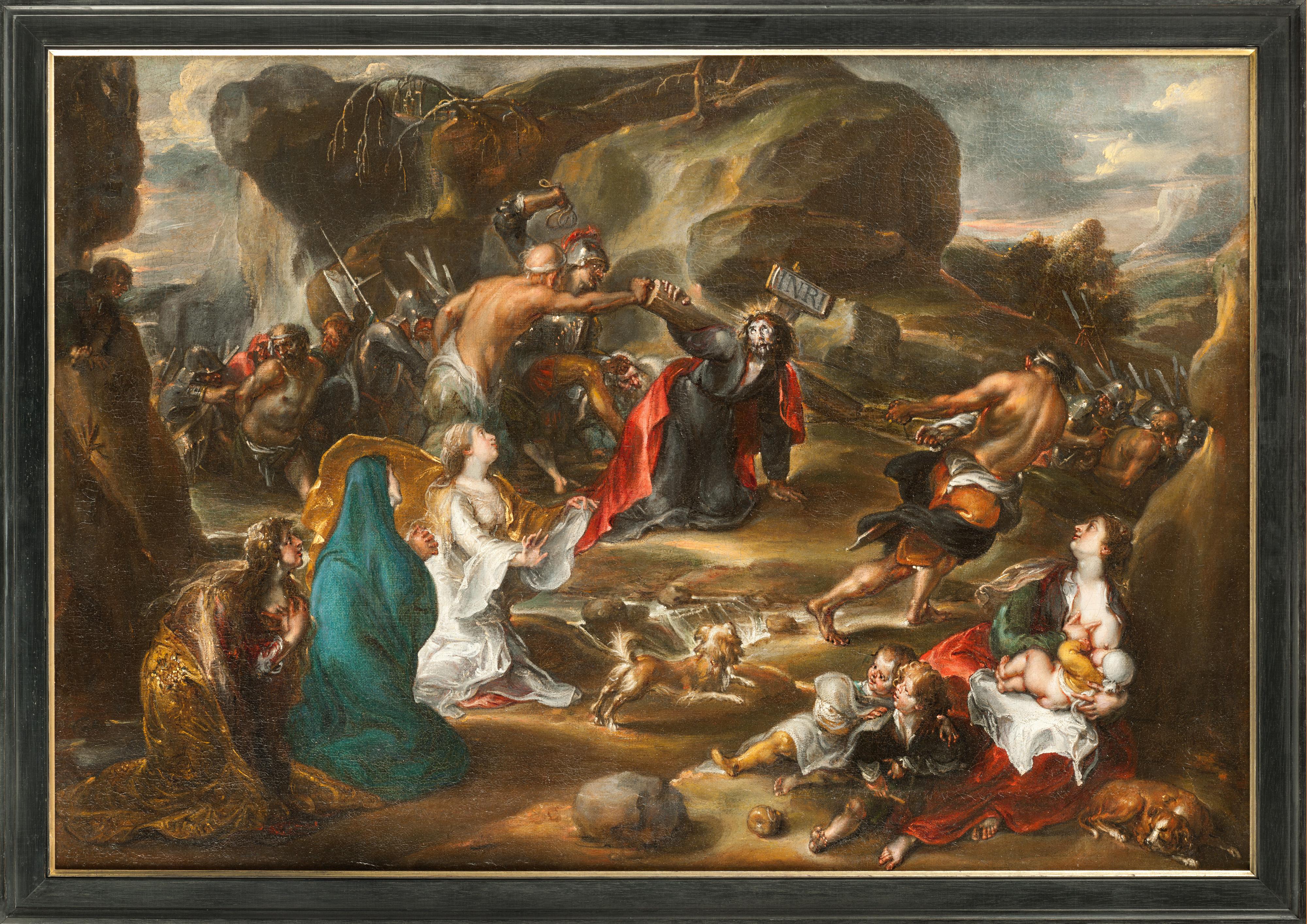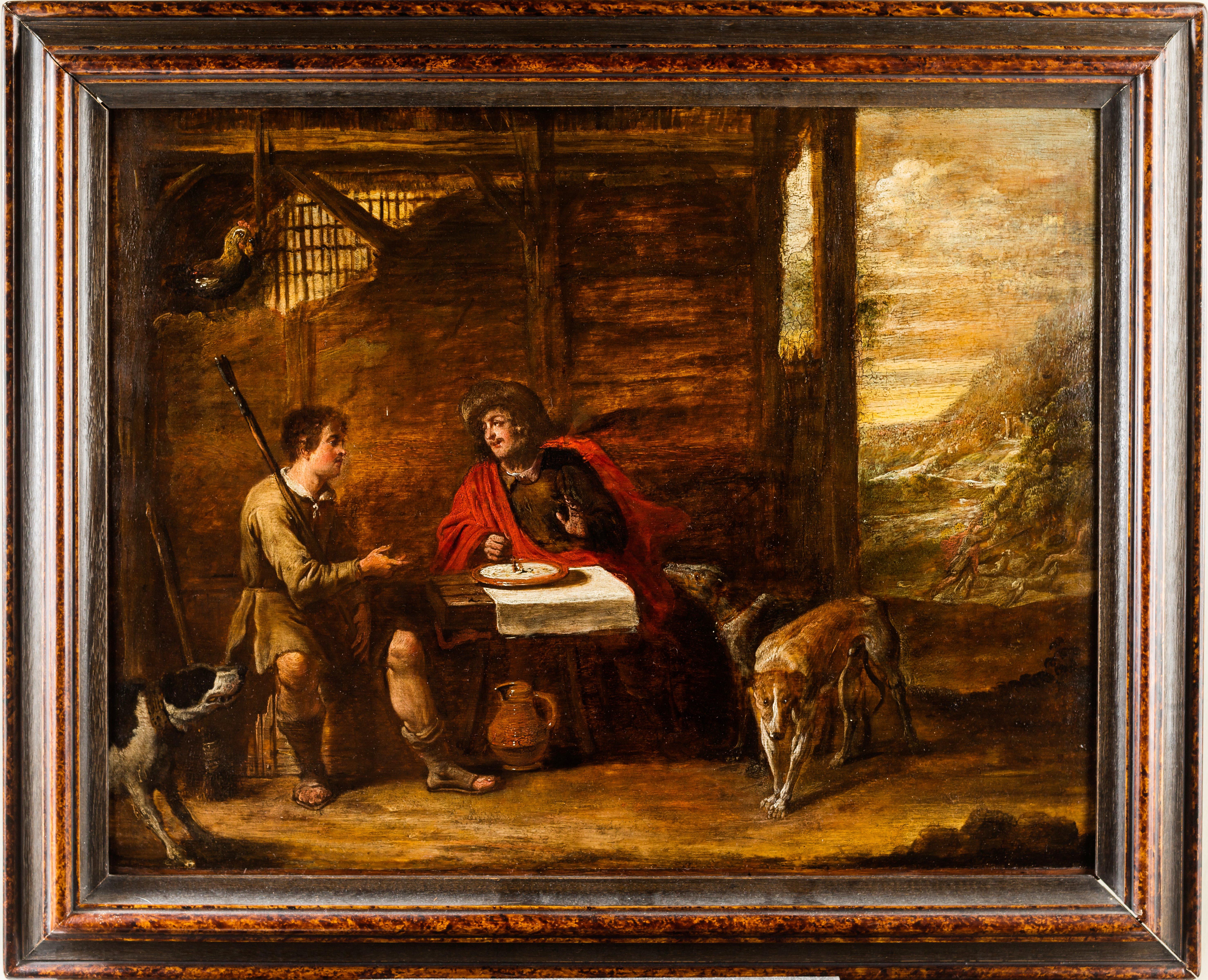Items Similar to Two Scenes of Diana and Actaeon (a pair)
Want more images or videos?
Request additional images or videos from the seller
1 of 4
Giovanni Battista ViolaTwo Scenes of Diana and Actaeon (a pair)
About the Item
Provenance:
Robert L. and Bertina Suida Manning, New York, until 1996
Private Collection, USA
Giovanni Battista Viola was born in Bologna and studied there with Annibale Carracci, whom he followed to Rome around 1601. He is documented the following year in Annibale’s studio and, for the next two decades worked with and for Annibale (who died in 1609), Francesco Albani, and Domenichino. Viola’s paintings were closest in spirit and style to Domenichino’s and indeed the authorship of many of their landscape paintings have been confused. Viola grew to become a specialist in the genre (but remained an indifferent figure painter), which lent itself to fertile collaboration with Domenichino, in fresco decoration and cabinet paintings. Perhaps most celebrated are the frescoes that once decorated the Stanza d’Apollo at the Villa Aldobrandini in Frascati—now in the National Gallery, London—in which Viola provided the landscape backgrounds to Domenichino’s figures.
This pair of jewel-like paintings on copper are superb examples of Viola’s intimate essays in landscape. The mythological subjects are almost incidental to the composition. In one Actaeon, accompanied by his dog, is seen firing an arrow at an unseen quarry. In the other he has surprised the naked Diana at her bath and is seen being transformed into a stag. But the real subject for both are the luminous landscapes, romantic evocations of an ideal world with rolling hills, verdant foliage, and distant mountains—all beneath twilight cloud-filled skies.
Dr. Francesca Cappelletti has confirmed Viola’s authorship of these paintings based on firsthand inspection. Besides the clear bonds to Domenichino and Annibale Carracci, she notes the affinities with Northern landscape specialists active in Rome, particularly Paul Bril, with whom Viola collaborated on several occasions.
- Creator:Giovanni Battista Viola (1576 - 1622, Italian)
- Dimensions:Height: 9 in (22.86 cm)Width: 11.12 in (28.25 cm)
- Medium:
- Movement & Style:
- Period:
- Condition:
- Gallery Location:New York, NY
- Reference Number:1stDibs: LU102342462

About the Seller
5.0
Recognized Seller
These prestigious sellers are industry leaders and represent the highest echelon for item quality and design.
Established in 1997
1stDibs seller since 2012
17 sales on 1stDibs
Typical response time: 11 hours
- ShippingRetrieving quote...Ships From: New York, NY
- Return PolicyThis item cannot be returned.
More From This SellerView All
- Ezekiel in the Valley of Dry BonesBy Philip Burne-JonesLocated in New York, NYProvenance: Christie’s, London, 3 March 1922, lot 46 (with The Tower of Babel); James Nicoll Private Collection Sotheby’s, London, 29 March 1983, lot 157 Private Collection, New Yo...Category
Late 19th Century Victorian Figurative Paintings
MaterialsCanvas, Oil
- Joseph Holding the Christ ChildBy Pietro BardellinoLocated in New York, NYProvenance: Private Collection, Argentina. A work of great delicacy and intimacy, this small painting on copper by Pietro Bardellino treats a subject which grew in popularity during the Baroque period: Saint Joseph and the Christ child...Category
18th Century Baroque Paintings
MaterialsCopper
- Three AngelsBy Domenico Piola the ElderLocated in New York, NYProvenance: Robert L. and Bertina Suida Manning, New York, until 1996 Private Collection, USA One of the leading artists in Genoa during the second half of the seventeenth century, Domenico Piola came from a successful family of artists, renowned for their many illusionistic ceiling programs throughout Genoese churches and palaces. A prolific draughtsman and painter, Domenico oversaw an extremely productive studio. In addition to his collaborations with numerous other artists, Domenico also provided many designs for book illustrations and prints that circulated throughout Europe, earning him international exposure and high acclaim in his own day. As Dr. Anna Orlando has indicated (written communication), the present work is an early work by Piola, datable from the late 1640s. At this time the young artist came strongly under the influence of Castiglione and Valerio Castello, while admiring the works of Giulio Cesare Procaccini. Piola’s works from this period are exuberant and fluid, and the artist’s love of portraying children is evident from the angels and putti that populate both his altarpieces and more intimate paintings. The present work depicts three angels...Category
17th Century Baroque Figurative Paintings
MaterialsCanvas, Oil
- Allegory of AbundanceLocated in New York, NYPainted in collaboration with Hendrick van Balen (Antwerp, 1575 – 1632). Provenance: Private Collection, Uruguay, since the 1930s. The eldest son of Jan Br...Category
17th Century Old Masters Paintings
MaterialsCopper
- Esther in the Women's House of AhasuerusBy Artus WolfortLocated in New York, NYBorn in Antwerp, Artus Wolffordt received his training in Dordrecht where he became a master in 1603 at the age of twenty-two. He returned to his native city in 1615 and initially worked as an assistant to Otto van Veen...Category
17th Century Old Masters Paintings
MaterialsOil, Panel
- Head of an AngelLocated in New York, NYProcaccini was born in Bologna, but his family moved to Milan when the artist was eleven years old. His artistic education was evidently familial— from his father Ercole and his elder brothers Camillo and Carlo Antonio, all painters—but his career began as a sculptor, and at an early age: his first known commission, a sculpted saint for the Duomo of Milan, came when he was only seventeen years old. Procaccini’s earliest documented painting, the Pietà for the Church of Santa Maria presso San Celso in Milan, was completed by 1604. By this time the artist had made the trip to Parma recorded by his biographers, where he studied Correggio, Mazzola Bedoli, and especially Parmigianino; reflections of their work are apparent throughout Procaccini's career. As Dr. Hugh Brigstocke has recently indicated, the present oil sketch is preparatory for the figure of the angel seen between the heads of the Virgin and St. Charles Borrommeo in Procaccini's altarpiece in the Church of Santa Afra in Brescia (ill. in Il Seicento Lombardo; Catalogo dei dipinti e delle sculture, exh. cat. Milan 1973, no. 98, pl. 113). As such it is the only known oil sketch of Procaccini's that can be directly connected with an extant altarpiece. The finished canvas, The Virgin and Child with Saints Charles Borrommeo and Latino with Angels, remains in the church for which it was painted; it is one of the most significant works of Procaccini's maturity and is generally dated after the artist's trip to Genoa in 1618. The Head of an Angel is an immediate study, no doubt taken from life, but one stylistically suffused with strong echoes of Correggio and Leonardo. Luigi Lanzi, writing of the completed altarpiece in 1796, specifically commented on Procaccini's indebtedness to Correggio (as well as the expressions of the angels) here: “Di Giulio Cesare...Category
17th Century Old Masters Figurative Paintings
MaterialsCanvas, Paper, Oil
You May Also Like
- 17th century Italian figure painting - Fall of Fetonte - Oil on copper LandscapeLocated in Varmo, ITRoman master (c. 1650) - The Fall of Phaeton. 40.5 x 52.5 cm without frame, 56.5 x 59.5 cm with frame. Oil on copper, in carved and gilded wooden fra...Category
Mid-17th Century Baroque Figurative Paintings
MaterialsCopper
- Soldiers by a Tent, Soldiers Camp, Circle Van Huchtenburg, Old Master PaintingBy Jan van HuchtenburgLocated in Greven, DECircle of Jan van Huchtenburg Landscape Scene with a Soldiers Camp Oil on Canvas, 41 x 55 cm Soldier Camp Life Scene together with a wonderful golden FrameCategory
18th Century Baroque Landscape Paintings
MaterialsOil, Canvas
- Christ Carrying the Cross, Old Master, Flemish, De Vos, Religious Scene, RubensBy Simon de VosLocated in Greven, DEThe scene of Christ carrying the cross is imagined in a rocky landscape. Two soldiers press the cross onto his shoulders, another leads him, holding the rope. A line of soldiers and prisoners moves from right to left. In front of them the three Marys kneel and pray for Christ. A nursing woman, symbol of Caritas, sits in the right foreground. Some dogs and playing kids enliven the scenery. Simon de Vos was born in Antwerp, and was first taught by Cornelis de Vos...Category
17th Century Baroque Figurative Paintings
MaterialsCanvas, Oil
- Old Master Painting, Flemish Baroque, Religious Scene, Esau and Jacob, LentilBy Erasmus Quellinus the YoungerLocated in Greven, DEIsaac and Rebecca had two sons: the twins Esau and Jacob. Esau was the first-born, giving him the birthright. Among Jews the birthright gave the eldest son authority over the family,...Category
17th Century Baroque Figurative Paintings
MaterialsOil, Panel
- Circle of Jacob Ruisdael, Landscape with Riders and a Well, Flemish ArtLocated in Greven, DECircle of Ruisdael, Riders in a Landscape passing by a wellCategory
17th Century Baroque Figurative Paintings
MaterialsPanel, Oil
- Frans Wouters, Adoration of The Herders, Christmas Scene, Christ, Flemish SchoolLocated in Greven, DEFrans Wouters was a Flemish Baroque painter who mainly created smaller cabinet pieces. He was initially apprenticed to Pieter van Avont in Antwerp, but then moved to Rubens‘ worksho...Category
17th Century Baroque Figurative Paintings
MaterialsOak, Oil
Recently Viewed
View AllMore Ways To Browse
Pair Of Baroque Cabinets
Stag Painting
Painting Of Stag
Pair Of Dog Paintings
Copper Dog
Baroque Dog
Oil On Copper Painting 17th Century
Antique Bath Cabinet
Copper Bath Used
Oil Paintings Of Stags
Annibale Carracci
Stag Figure
Antique Stag Painting
Stag Oil Painting
Antique Bonds
Copper Dog Antique
Apollo And Diana
Antique Violas


